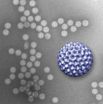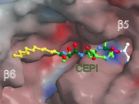(Press-News.org) If the key to winning battles is knowing both your enemy and yourself, then scientists are now well on their way toward becoming the Sun Tzus of medicine by taking a giant step toward a priceless advantage – the ability to see the soldiers in action on the battlefield.
Investigators at the Virginia Tech Carilion Research Institute have invented a way to directly image biological structures at their most fundamental level and in their natural habitats. The technique is a major advancement toward the ultimate goal of imaging biological processes in action at the atomic level.
"It's sort of like the difference between seeing Han Solo frozen in carbonite and watching him walk around blasting stormtroopers," said Deborah Kelly, an assistant professor at the VTC Research Institute and a lead author on the paper describing the first successful test of the new technique. "Seeing viruses, for example, in action in their natural environment is invaluable."
The technique involves taking two silicon-nitride microchips with windows etched in their centers and pressing them together until only a 150-nanometer space between them remains. The researchers then fill this pocket with a liquid resembling the natural environment of the biological structure to be imaged, creating a microfluidic chamber.
Then, because free-floating structures yield images with poor resolution, the researchers coat the microchip's interior surface with a layer of natural biological tethers, such as antibodies, which naturally grab onto a virus and hold it in place.
In a recent study in Lab on a Chip, Kelly joined Sarah McDonald, also an assistant professor at the VTC Research Institute, to prove that the technique works.
McDonald provided a pure sample of rotavirus double-layered particles for the study.
"What's missing in the field of structural biology right now is dynamics – how things move in time," said McDonald. "Debbie is developing technologies to bridge that gap, because that's clearly the next big breakthrough that structural biology needs."
Rotavirus is the most common cause of severe diarrhea among infants and children. By the age of 5, nearly every child in the world has been infected at least once. And although the disease tends to be easily managed in the developed world, in developing countries rotavirus kills more than 450,000 children a year.
At the second step in the pathogen's life cycle, rotavirus sheds its outer layer, which allows it to enter a cell, and becomes what is called a double-layered particle. Once its second layer is exposed, the virus is ready to begin using the cell's own infrastructure to produce more viruses. It was the viral structure at this stage that the researchers imaged in the new study.
Kelly and McDonald coated the interior window of the microchip with antibodies to the virus. The antibodies, in turn, latched onto the rotaviruses that were injected into the microfluidic chamber and held them in place. The researchers then used a transmission electron microscope to image the prepared slide.
The technique worked perfectly.
The experiment gave results that resembled those achieved using traditional freezing methods to prepare rotavirus for electron microscopy, proving that the new technique can deliver accurate results.
"It's the first time scientists have imaged anything on this scale in liquid," said Kelly.
The next step is to continue to develop the technique with an eye toward imaging biological structures dynamically in action.
Specifically, McDonald is looking to understand how rotavirus assembles, so as to better know and develop tools to combat this particular enemy of children's health.
The researchers said their ongoing collaboration is an example of the cross-disciplinary work that is becoming a hallmark of the VTC Research Institute.
"It's an ideal collaboration because Sarah provides a phenomenal model system by which we can develop new technologies to move the field of microstructural biology forward," said Kelly.
"It's very win-win," McDonald added. "While the virus is a great tool for Debbie to develop her techniques, her technology is critical for allowing me to understand how this deadly virus assembles and changes dynamically over time."
INFORMATION:
The paper "Visualizing viral assemblies in a nanoscale biosphere" was published online and will appear in a 2013 edition of Lab on a Chip.
The authors are Brian Gilmore, a research associate at the VTC Research Institute; Shannon Showalter, a research assistant at the VTC Research Institute; Madeline Dukes, an applications scientist at Protochips; Justin Tanner, a postdoctoral associate at the VTC Research Institute; Andrew Demmert, a student at the Virginia Tech Carilion School of Medicine; McDonald, in addition to her position at the VTC Research Institute, is an assistant professor of biomedical sciences and pathobiology in the Virginia–Maryland Regional College of Veterinary Medicine; and Kelly, in addition to her position at the VTC Research Institute, is an assistant professor of biological sciences in Virginia Tech's College of Science.
This article was written by Ken Kingery.
A nanoscale window to the biological world
In situ molecular microscopy provides a gateway to imaging dynamic systems in structural biology
2012-12-20
ELSE PRESS RELEASES FROM THIS DATE:
Production of 5-aminovaleric and glutaric acid by metabolically engineered microorganism
2012-12-20
We use many different types of chemicals and plastics for the convenience of our everyday life. The current sources of these materials are provided from petrochemical industry, using fossil oil as a raw material. Due to our increased concerns on the environmental problems and fossil resource availability, there has been much interest in producing those chemicals and materials from renewable non-food biomass through biorefineries. For the development of biorefinery process, microorganisms have successfully been employed as the key biocatalysts to produce a wide range of ...
Game changing diagnostic & prognostic prostate cancer genetic tests revealed by Jefferson
2012-12-20
PHILADELPHIA—Researchers at the Kimmel Cancer Center at Jefferson (KCC) (insert link to "Kimmel Cancer Center at Jefferson" www.kimmelcancercenter.org) have developed potentially game-changing diagnostic and prognostic genetic tests shown to better predict prostate cancer survival outcomes and distinguish clinically-relevant cancers.
The team, led by Richard G. Pestell, M.D., Ph.D., Director of the KCC and the Chair of the Department of Cancer Biology at Thomas Jefferson University, report their preclinical findings from a blinded, retrospective analysis of over 350 ...
Can observations of a hardy weed help feed the world?
2012-12-20
As the human population increases, so too do the demands and stresses on agriculture. In the January 2013 issue of International Journal of Plant Sciences, Penn State University Waller Professor of Plant Biology Dr. Sarah Assmann explores how the responses to environmental stresses by one small, genetically diverse plant species might illuminate possible approaches to addressing growing human demand for crop products amid decreasing resources.
In the article, Dr. Assmann describes how human population growth presents new challenges to twenty-first-century agriculture, ...
Serendipity points to new potential target and therapy for melanoma
2012-12-20
A University of Colorado Cancer Center study in this month's edition of the Journal of Investigative Dermatology describes a new target and potential treatment for melanoma, the most dangerous form of skin cancer. MicroRNA can decide which genes in a cell's DNA are expressed and which stay silent. Melanoma tends to lack microRNA-26a, which makes the gene SODD go silent.
"It's a double negative," says Yiqun Shellman, PhD, investigator at the CU Cancer Center, associate professor at the CU School of Medicine, and the study's co-senior author. "miR-26a works to stop the ...
Cultural, social factors identified as barriers to minority participation in stem cell donation
2012-12-20
New research examining the role of race and ethnicity in an individual's decision to become a donor for hematopoietic cell transplantation (HCT) identifies several factors associated with varied participation rates in national donor registries across racial/ethnic groups. Results of this first-of-its-kind study are published online today in Blood, the Journal of the American Society of Hematology (ASH).
Hematopoietic cell transplants serve as valuable treatments for a range of blood disorders, as they generate new, healthy blood cells to replace diseased cells. While ...
Poison for cancer cells
2012-12-20
This press release is available in German.
In their quest for new agents, pharmaceutical researchers test millions of substances all over the world. They like using color-forming reactions to identify new molecules. However, in intensively colored solutions or in the case of mixtures with multiple substances these tests fail. As part of his doctoral thesis, Martin Stein, member of staff at the Chair of Biochemistry at the Technische Universitaet Muenchen, developed a testing reaction based on magnetic resonance data. It helps find a specific pharmaceutical molecule ...
Clean air: New paints break down nitrogen oxides
2012-12-20
The Seventies: Smog alert in the Ruhr area, acid rain, dying spruce trees in the Bavarian Forest. In those days, the solution was filter systems for the smokestacks in the Ruhr area. Today, people in the urban areas are suffering from high levels of pollution that is being caused by, among other things, automotive traffic. Particularly undesired: the nitrogen oxides (NOX). In the meantime, the European Union tightened the limit values even further; in many communities they are being exceeded. Michael Hüben of the Fraunhofer Institute for Molecular Biology and Applied Ecology ...
Aldrich Materials Science discovers liquid-free preparation of metal organic frameworks
2012-12-20
St. Louis, MO – December 18, 2012 – Researchers at Aldrich Materials Science, a strategic technology initiative of Sigma-Aldrich Corporation (NASDAQ:SIAL) have discovered an innovative way to design an important class of three-dimensional (3D) hybrid structures, Metal Organic Frameworks (MOFs), under completely liquid-free conditions. High purity MOF products prepared by the liquid-free process may be ideally suited as rare earth containing materials for sensors and detectors, electronic or magnetic materials. The discovery also extends liquid-free preparation techniques ...
Pair of proteins gets brain cells into shape
2012-12-20
This press release is available in German.
The study conducted by Prof. Frank Bradke's team provides indications on brain development and about the causes of diseases of the nervous system. The results have now been published in "Neuron".
Under the microscope, the brain appears as a network of intricate beauty comprising billions of nerve cells (the so-called "neurons") linked together. This network is engaged in a constant process of sharing information. The signals are transmitted from neuron to neuron through fine ramifications of the cell body. However, to acquire ...
University of Alberta research working towards treatment for aortic aneurysms in the abdomen
2012-12-20
A researcher with the Faculty of Medicine & Dentistry and the Mazankowski Alberta Heart Institute is looking closely at a molecule linked to aortic aneurysms in the abdomen, and her findings could lead to a treatment to reduce swelling of the aortic artery, which would be a life-saving treatment.
Zamaneh Kassiri, a professor in the Department of Physiology, and Ratnadeep Basu, a PhD trainee in Kassiri's lab, have been looking at the role of a protein called TIMP3 in the vessels. Their most recent findings, published in The Journal of Biological Chemistry, shows that animal ...
LAST 30 PRESS RELEASES:
This new understanding of T cell receptors may improve cancer immunotherapies
A new fossil face sheds light on early migrations of ancient human ancestor
A new immunotherapy approach could work for many types of cancer
A new way to diagnose deadly lung infections and save lives
40 percent of MRI signals do not correspond to actual brain activity
How brain-inspired algorithms could drive down AI energy costs
Gum disease may be linked to plaque buildup in arteries, higher risk of major CVD events
Contrails are a major driver of aviation’s climate impact
Structure of dopamine-releasing neurons relates to the type of circuits they form for smell-processing
Reducing social isolation protects the brain in later life
Keeping the heart healthy increases longevity even after cancer
Young adults commonly mix cannabis with nicotine and tobacco
Comprehensive review illuminates tau protein's dual nature in brain health, disease, and emerging psychiatric connections
Book prepares K-12 leaders for the next public health crisis
Storms in the Southern Ocean mitigates global warming
Seals on the move: Research reveals key data for offshore development and international ecology
Sports injuries sustained during your period might be more severe
World's first successful 2 Tbit/s free-space optical communication using small optical terminals mountable on satellites and HAPS
Can intimate relationships affect your heart? New study says ‘yes’
Scalable and healable gradient textiles for multi‑scenario radiative cooling via bicomponent blow spinning
Research shows informed traders never let a good climate crisis go to waste
Intelligent XGBoost framework enhances asphalt pavement skid resistance assessment
Dual-function biomaterials for postoperative osteosarcoma: Tumor suppression and bone regeneration
New framework reveals where transport emissions concentrate in Singapore
NTP-enhanced lattice oxygen activation in Ce-Co catalysts for low-temperature soot combustion
Synergistic interface engineering in Cu-Zn-Ce catalysts for efficient CO2 hydrogenation to methanol
COVID-19 leaves a lasting mark on the human brain
Scientists use ultrasound to soften and treat cancer tumors without damaging healthy tissue
Community swimming program for Black youth boosts skills, sense of belonging, study finds
Specific depressive symptoms in midlife linked to increased dementia risk
[Press-News.org] A nanoscale window to the biological worldIn situ molecular microscopy provides a gateway to imaging dynamic systems in structural biology



